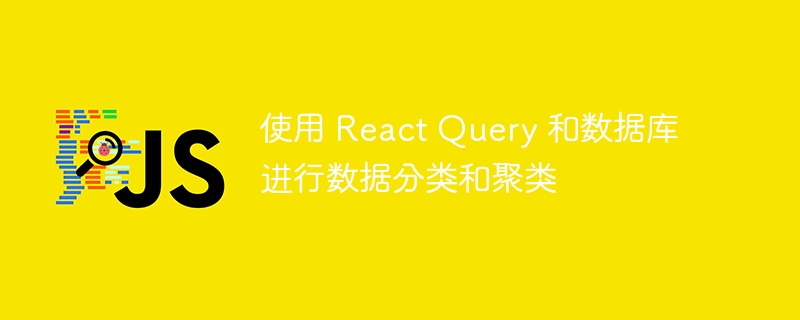Home >Web Front-end >JS Tutorial >Data classification and clustering using React Query and a database
Data classification and clustering using React Query and a database
- PHPzOriginal
- 2023-09-26 18:07:41908browse

Data classification and clustering using React Query and database
Introduction:
Data classification and clustering are very important in developing modern web applications. One of the common requirements. This can be easily achieved using React Query and a database. React Query is a powerful library for getting and managing data asynchronously and storing and retrieving data using a database. This article will introduce in detail how to use React Query and database to implement data classification and clustering.
Step 1: Prepare the database
First, we need to prepare a database to store and retrieve data. You can choose to use a relational database such as MySQL or PostgreSQL, or a non-relational database such as MongoDB or Firebase. Here we take MongoDB as an example. Create a collection named "categories" to store category information. Each category document contains a "name" field and a "count" field to record the number of data under the category.
Step 2: Set up React Query
Next, we need to set up React Query to handle data acquisition and update. In the root component, we need to use the 64da5f605a090d2f2afeaf6c3e03b4d0 component to provide the context of React Query and create a Query Client object to handle data acquisition and update.
import { QueryClient, QueryClientProvider } from 'react-query';
const queryClient = new QueryClient();
function App() {
return (
<QueryClientProvider client={queryClient}>
// 应用程序的其他组件
</QueryClientProvider>
);
}
export default App;Step 3: Obtain data
In order to obtain data and classify and cluster it, we can use the useQuery hook in React Query to initiate an asynchronous request. In a custom useState hook, we can use React Query's useMutation hook to handle data updates.
import { useQuery, useMutation } from 'react-query';
function useCategories() {
return useQuery('categories', async () => {
const response = await fetch('/api/categories');
return response.json();
});
}
function useUpdateCategory() {
return useMutation((category) => {
// 更新分类数据的请求
});
}In the above code, we use the fetch function to obtain categorical data, and use useMutation to define the operation of updating categorical data.
Step 4: Render data
In other components of the application, we can use the useCategories hook to obtain the category data, and use the useUpdateCategory hook to update the category data. Then, we can perform classification and clustering operations based on the number of classified data.
import { useCategories, useUpdateCategory } from './hooks';
function Categories() {
const { data: categories, isLoading } = useCategories();
const updateCategory = useUpdateCategory();
if (isLoading) {
return <div>Loading...</div>;
}
return (
<div>
{categories.map((category) => (
<div key={category.id}>
<span>{category.name}</span>
<span>{category.count}</span>
<button onClick={() => updateCategory.mutate(category)}>Update</button>
</div>
))}
</div>
);
}In the above code, we use the map function to traverse the category data and render the name, quantity and an update button of each category. When the update button is clicked, the operation defined in the useUpdateCategory hook will be called to update the category data.
Summary:
Using React Query and a database for data classification and clustering is very simple and efficient. By preparing the database, setting up React Query and using the appropriate hooks, we can easily obtain the data and perform corresponding operations. I hope this article can help you achieve your data classification and clustering needs.
The above is the detailed content of Data classification and clustering using React Query and a database. For more information, please follow other related articles on the PHP Chinese website!
Related articles
See more- An in-depth analysis of the Bootstrap list group component
- Detailed explanation of JavaScript function currying
- Complete example of JS password generation and strength detection (with demo source code download)
- Angularjs integrates WeChat UI (weui)
- How to quickly switch between Traditional Chinese and Simplified Chinese with JavaScript and the trick for websites to support switching between Simplified and Traditional Chinese_javascript skills

